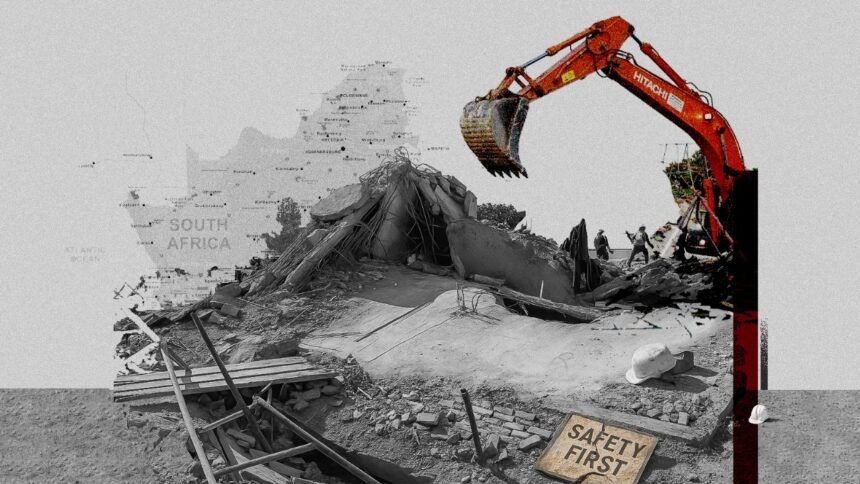There are few things more terrifying than a building crumbling under your feet—and few things more damning than knowing it could’ve been prevented. In George, a small city in South Africa’s Western Cape, tragedy struck recently when a five-storey building under construction collapsed, killing 34 people and injuring many others. But what’s worse is this: the warnings came before the concrete did.
According to workers and early eyewitness reports, tremors and unsettling vibrations were reported just days before the collapse. Yet construction continued. Why? That’s the question reverberating across South Africa now—not just among the families of the dead, but also in the halls of government, boardrooms, and labor unions.
It was supposed to be a symbol of progress. Instead, it became a graveyard of negligence.
In the immediate aftermath, rescue workers scrambled in 24-hour shifts to save lives. Locals described scenes reminiscent of earthquake zones: dust-choked skies, twisted rebar, scattered helmets. Over 100 workers were on-site when it happened, many of them young breadwinners from townships and rural villages. As the days passed and the death toll mounted, so did the outrage.
The Minister of Public Works and Infrastructure didn’t mince words, calling the disaster “entirely preventable.” But saying so now feels like a tragic admission. Where were the oversight mechanisms? Why wasn’t construction halted the moment workers felt unsafe?
It’s tempting to blame one company, or one individual. But the rot runs deeper. South Africa, like many developing economies, faces a grim tug-of-war between economic growth and safety standards. Rapid urbanization, rising demand for affordable housing, and a sluggish economy mean contractors often cut corners, regulations are inconsistently enforced, and inspectors are spread too thin—or worse, compromised.
South Africa’s construction industry has long had a reputation problem. Accusations of substandard materials, bribery in permit approvals, and even falsified safety certifications have surfaced in the past. But the George collapse might be the moment the country stops ignoring them.
Already, the investigation is drawing in municipal authorities, private engineers, and regulatory bodies. There are murmurs of possible criminal negligence. The site’s project managers have gone silent. Families are preparing lawsuits. Civil society groups are demanding a nationwide audit of all ongoing construction projects. And the government, feeling the heat, has pledged reforms.
But will anything change?
This isn’t the first major building disaster in post-apartheid South Africa. Nor is it unique. Similar tragedies have occurred in Lagos, Nairobi, and Cairo, where rapid urban expansion outpaces regulatory muscle. What makes George different is the clarity of its preventability. The victims didn’t die from an act of God; they died from human indifference.
In a country already grappling with political scandals, energy blackouts, and economic inequality, the collapse in George has tapped into a deeper sense of betrayal. The idea that even basic physical safety cannot be guaranteed has a chilling effect on national morale.
For now, the city mourns. Vigils are being held. Community groups are organizing food drives for families of the deceased. And the rest of the nation watches with a mixture of sorrow and fury.
If there’s any justice to be salvaged, it must come in the form of systemic change. This means more than just scapegoating one contractor. It means revamping the building inspection framework, investing in training and ethics in the construction sector, and—crucially—protecting whistleblowers when they speak up.
Because next time, it might not be a building under construction. It could be a school. A hospital. A home.
And the tremors of neglect, once again, would go unheard until it’s too late.










